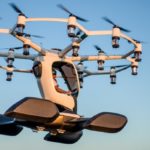Cranfield Airport’s new Digital Air Traffic Control Centre has been officially opened by the UK Aviation Minister, Liz Sugg. The airport is the first in the UK to have an operational digital air traffic control centre.
Over the next few months, the airport will continue its work with the regulator, the Civil Aviation Authority (CAA), in order to complete the transition from a traditional air traffic control tower to the new digital centre.
Supplied by Saab Digital Air Traffic Solutions, the technology replicates what can be seen through the windows of a traditional air traffic control tower. It enables smarter approaches to air traffic control by digitising and integrating airport functions and improves a controller’s situational awareness, enabling quick and informed decisions.
The new system provides controllers with a 360-degree view of the airport and the ability to zoom-in on aircraft, improving visibility.
Digital aviation
There are no digital control towers currently fully operational at UK airports. In 2015, the airports in Örnsköldsvik and Sundsvall in Sweden became the first in the world to be controlled via digital air traffic control in Sundsvall.
Digital aviation has often been cited as being the next significant business transformation in the sector and one which can support the aerospace industry towards delivering greater customer satisfaction while addressing efficiency, cost and capacity issues.
With the pace of air travel growth already causing strains across the sector, and UK passenger numbers expected to increase by 49% by 2050, solutions other than expansion of airport capacity and ground infrastructure need to be found.
DARTEC
As well as serving Cranfield Airport, which is owned by Cranfield University, the Digital Air Traffic Control Centre is an integral part of the £67 million Digital Aviation Research and Technology Centre (DARTeC). Scheduled to open in 2020, DARTeC will address research challenges facing the aviation industry such as:
- the integration of drones into civilian airspace;
- increasing the efficiency of airports through technological advances;
- creating safe, secure shared airspace through secure data communication infrastructures; and
- increasing the reliability and availability of aircraft through self-sensing, self-aware technologies.
Watch our interview about DARTEC with Iain Gray, Director of Aerospace, Cranfield University:
UK Aviation Minister, Liz Sugg, said: “Cranfield’s new control centre is a fantastic example of harnessing technology to improve the efficiency of flights.
“The upcoming Aviation Strategy consultation will set out how the Government proposes to encourage the use of innovative technology to achieve sustainable aviation growth and enhance passengers’ experience.”
Rob Abbott, Cranfield Airport’s Director of Aviation Operations, said: “This is an exciting time for us. The installation of the new Digital Air Traffic Control Centre, as well as significant upgrades to Cranfield Airport’s infrastructure and capabilities, will put us at the forefront of digital aviation.”

